33 TA concepts for mediation
- and what you can do with it.
This is going to be a long blog post.
I would therefore like to point out something The obvious in the digital world point out. In view of the possibilities in a network, dear reader, there is no need to split this blog post into two or more individual posts. You can read this one post in bites, both in terms of time and scope, so that it remains easy to digest ;-)
Today I would like to 33 TA concepts for work in the Mediation introduce.
Of course, there are other methods and concepts that a mediator needs - depending on the case and situation - in order to be able to make and verbalise appropriate analyses and hypotheses. More is also needed to formulate appropriate interventions. Likewise, TA has much more to offer than the 33 concepts below. Some may also be helpful for mediation and yet have not been listed here. Somewhere I wanted to limit myself.
These 33 TA concepts seem to me to be an appropriate number. In themselves, they already provide a comprehensive insight into the possibilities that TA offers mediators to develop their professional toolbox with transaction-analysis-based „Measuring and control instruments“ to top up.
Concept overview:
3. drama triangle from Karpman
4. triangular agreement according to English
11. communication model of transactional analysis
16. mediation matrix according to Kouwenhoven
17. basic feelings according to Thomson
18. substitute feelings after English
19. relationship needs of Erskine
20. driver dynamics according to Kahler
21. system dynamics according to Mohr
22. the 3 Ps according to Crossman
30th Bonding cycle according to Kohlrieser
31st Eight interventions after Berne
33. cultural diagnosis of organisations according to Balling
1. basic attitudes
They are the starting point for mediated conflict management. The concept of basic attitudes originates from Eric Berne from the beginnings of transactional analysis. The buzzword-like „I'm ok, you're ok “ holds the treasure for the mediator of not falling into the trap of escalating conflicts and personalising the conflict as a problem and apportioning blame. It is not the other people who are the problem, but their behaviour. Or as it is put in Harvard concept means: Separate the person from the problem - and solve it with them.

The concept can also be used to differentiate fundamental approaches and attitudes towards problems and conflicts, which can be used to structure different conflict styles and attempts to resolve them. In this respect, it is more of an analysis tool.
2. autonomy concept
Transactional analysis is based on the Tradition of humanistic psychology from this, that people want to mature and grow, make independent decisions and take responsibility for them – in short, in the language of the TA, that they want to act „autonomously“. Auto-nomos, self-legality. In mediation, this is captured by the principle of personal responsibility of all parties involved. Transactional analysis offers the appropriate human image for this, conceptualised in depth psychology and verbally packaged. The work of mediators is only worthwhile with such a humanistic view of humanity, because a method such as mediation is only necessary if they harbour the idea that people (want to) learn, grow and develop.
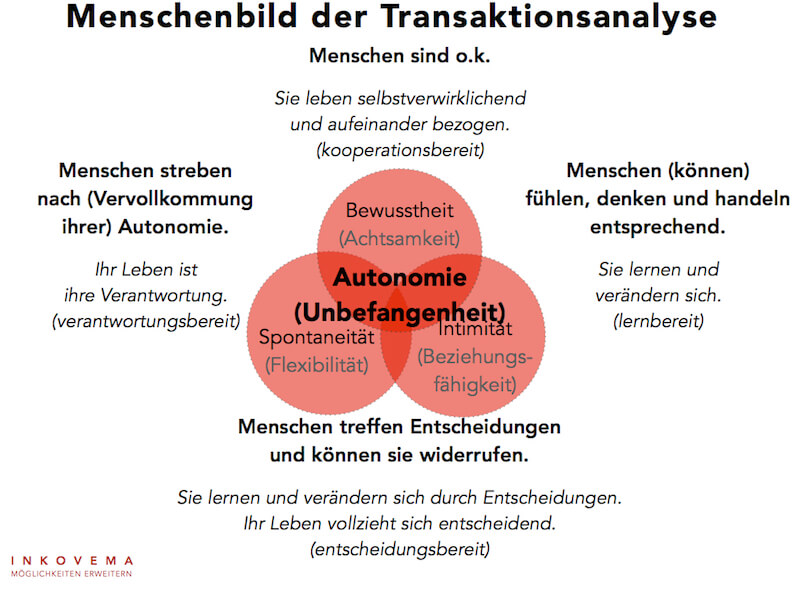
3. drama triangle from Karpman
In my opinion, the drama triangle is the TA „s concept for mediation“ par excellence. Anyone who has heard or read about it once will never forget it again. You can find a wonderful article by my colleague Luise Lohkamp in the Manual „TA in mediation“. It describes the Fundamental dynamics of escalating conflicts and helps to clarify how all those involved jointly create and maintain the conflict structures and support escalating dynamics. For me, this is a gem of transactional analysis that is perfect for mediation.
The drama triangle is, of course, also suitable for use in work settings other than mediation. It helps managers and employees to behave professionally and appropriately in conflict-prone situations.
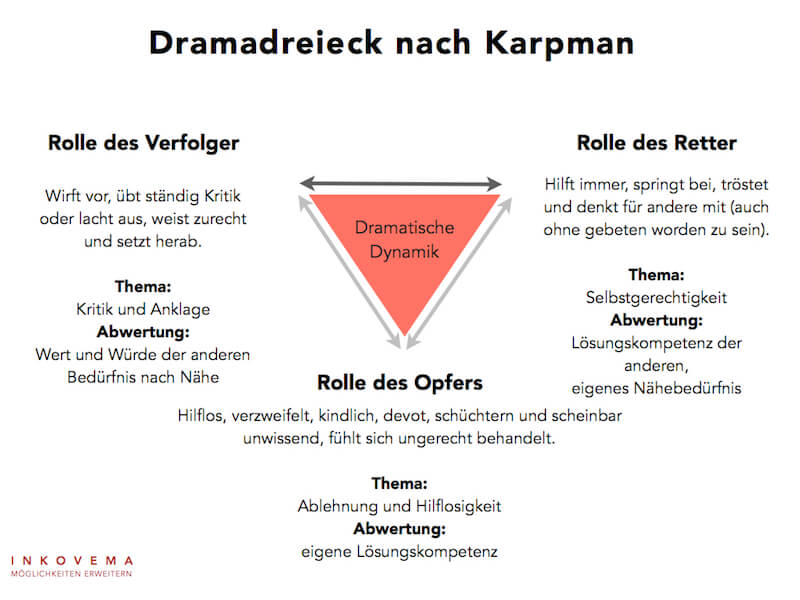
If you want to know more about the drama triangle, read this article.
4. triangular agreement according to English
The triangular agreement is a good way of using the contractual process in (organisationally anchored) mediations. (Concept No. 32) and clarify which agreements have been made and still need to be made between which parties, who has which obligations towards whom, so that ultimately everyone involved is aware of what they are working on and with whom.
This is particularly important if the client is not present. This is often the case when mediation takes place on behalf of an organisation. In this case, the role holder commissioning the mediation is usually not present. As a result, agreements are made between the client and the (external) mediator that the parties to the mediation do not realise or become aware of. This is where the concept of the triangular agreement helps to recognise the existing complexity and reduce it appropriately.
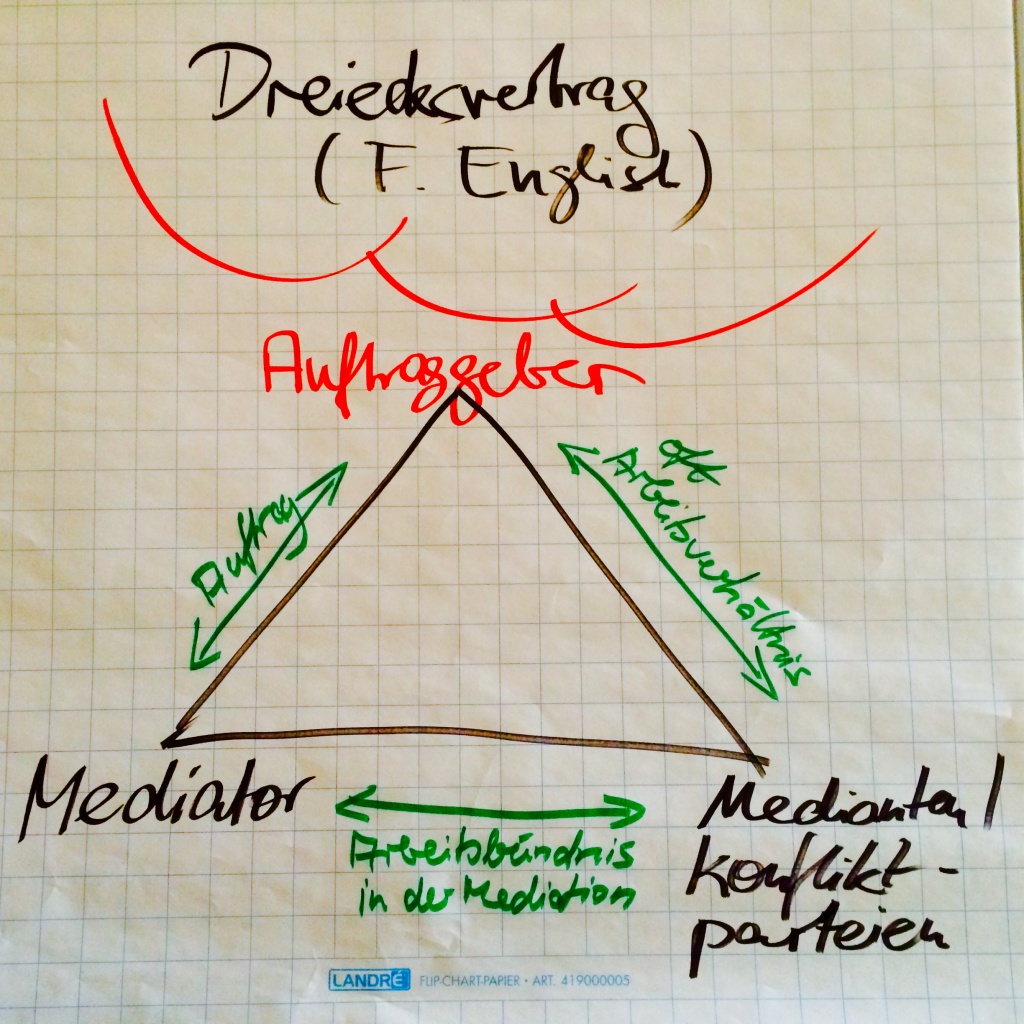
5. tangential transaction
Sometimes conflicting parties „always argue about the same“ thing. Especially in long-term (conflict) relationships, the same topics always seem to come up without mutual understanding being reached, let alone agreement. There seems to be a fork in the road of realising who the other person is or what they mean, which leads back to the starting point - from there, the journey starts again each time. A little more frustrated each time. Communication as a maze. Who wants to do that? communicate more with each other - like the "Panacea for the good-natured" reads.
This is not about „more communication“, but about Ability to engage in dialogue; the ability to relate to one another. The instrument for this is the concept of tangential transactions, which has become the „measurement and clarification tool“ of passivity models. (Concept No. 7-9) heard. Tangential transactions occur when the parties involved do not refer to each other, but only pick out a (tiny) part of the conflict partner's content and use it to talk about other things. Two tangential professionals can initiate a verbal game of cat and mouse without fully realising it. In the end, both are annoyed and angry with the other.
6. blocking transaction
Blocking transactions are the second form of redefining transactions (see also Concept No. 5). Just like tangential transactions, they (mostly) unconsciously serve to define one's own frame of reference. (Concept No. 7) and thus keep out new information that is sometimes relevant to solving problems.
They are therefore particularly common in conflict situations. All communicative shades from „The point is basically…!“ to „…but that doesn't really matter here, because the real question is…“ can be considered a Power-activating communicative blockades be understood.
7. frame of reference
The frame of reference represents the totality of the attributions of meaning, sense and value that a person makes in the face of what he or she encounters from „inside“ and „outside“. The individual frame of reference also contains elements that can be attributed to culture and social class. After all, we are social beings and learn from each other.
A suitable metaphor for the frame of reference is the pair of glasses through which people see the world individually and differently than without them.
The advantage of a frame of reference is that it provides psychological security „ and therefore helps to reduce complexity. This is why it is also defended against attacks, changes, etc. Conflict situations are always also threats to the frames of reference involved. Mediators should pay attention to this.
Communicative defence strategies are tangential and blocking transactions (Concepts no. 5 and 6)!
8. passivity in thinking
Transactional analysis calls thinking passive when information that would be relevant for solving a problem is unconsciously ignored. It names Four stages of passive thinking.
- The Hide the problem. (=“I have no conflict with you. That's your problem. “)
- The Devaluation of the problem. (=“That may be, but it's not as bad as you claim. After all, anyone could come!)
- The Insolubility of the problem is accepted. (=“That's bad, but it can't be changed“)
- The Own ability to find solutions is devalued. (=“That's bad, but I'm not in a position to solve the problem).
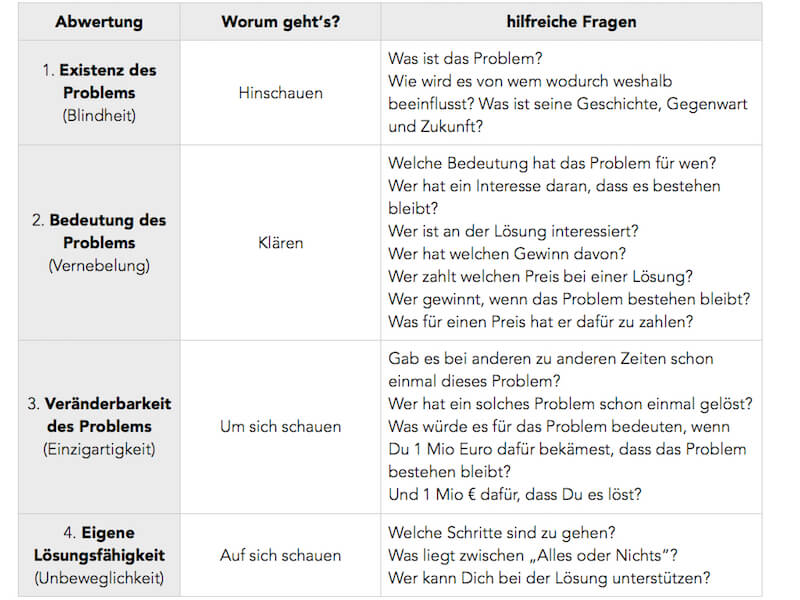
These stages help the mediator not to work on solutions with the mediants (stage 4!) if they still define the joint conflict as a problem of the other party (stage 1!) or degrade the other party to a problem (stage 2!) or or or or…, or at any rate do not yet harbour the idea that they are responsible for their conflict situation and that they are not responsible for the conflict. therefore are able to end them together. Mediators should therefore be familiar with the concept of passivity in order to interact with the mediants at the level at which problems and possible solutions are devalued.
9. passivity in action
The idea of passive action is part of the Concept package of the frame of reference, which also includes the passive thinking belongs to (Concept No. 8). The concept of transactional passivity makes it possible to identify any actions that do not solve problems. These include, for example, doing nothing (obvious passivity), over-adaptation (maximum activity, actionism), agitation (exerting pressure) and violence against oneself and others (which includes alcoholism).
10. devaluation matrix
The devaluation matrix is a working tool that is derived from the considerations on the Passivity has developed. It is an excellent diagnostic and intervention tool for intelligently structuring the problem and conflict resolution process. The content of the communication can be aligned with the devaluation matrix and provide the mediator with important impulses that the right questions at the right time to place. The devaluation matrix can therefore be combined well with the mediation matrix. (Concept No. 16) combined can be used.
How specifically the devaluation matrix is helpful for mediators has H. Schulze in the Handbook of transactional analysis in mediation in detail. There you will find a good essay that deals specifically with the topic.
However, the following graphic indicates the complexity of how, for example, an alcohol-dependent person could devalue their existing problem and the different "question objectives" that must be derived from this.
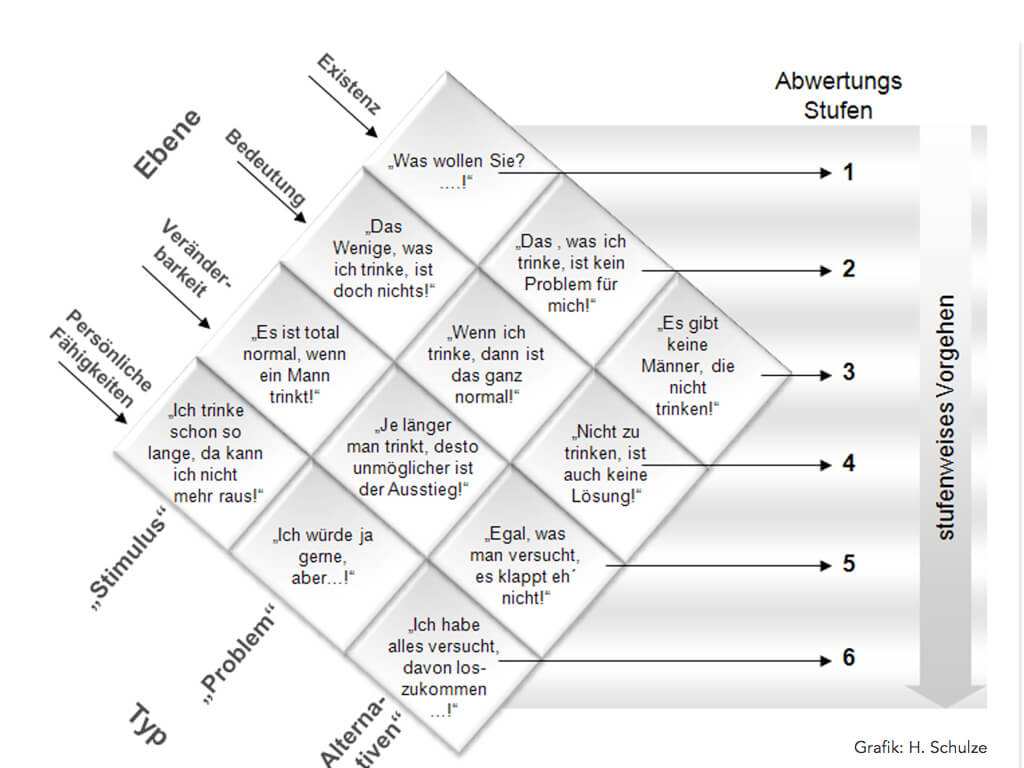
11. communication model of transactional analysis
The communication model of transactions is one of the main pillars of the entire "TA house". It is based on the classic sender-receiver model, whose uncertainty relations, however, follow the "systemic principles of input and output conflicts" (Gührs/Nowak). Transactional analysis in the narrow sense comprises three basic forms of transactions:
- complementary (parallel) transactions
- irritating (crossed) transactions
- disparate (hidden) transactions
Each sequence of communication, each action and reaction, can be assigned to one of these three forms of trans-actions. These forms can in turn give rise to patterns, so-called psychological games (Concept No. 15).
For the mediator, the concept is a real help in gaining a picture of conflict communication and its structures. Working with the concept is a little time-consuming at first, but practice not only makes perfect, but also makes work easier.
12. crossed transaction
Crossed transactions help the mediator to identify the conflict communication and visualise it graphically. This has Decelerating effect and helps to expectations disappointed on both sides can be discussed to make.
Understanding crossed transactions requires the Knowledge of the behavioural modes relevant to communication (functional model of ego states). This is TA's most significant contribution to general communication theory.
13. parallel transaction
In addition to the crossed transactions (Concept No. 12) parallel transactions are interactions that correspond to mutual expectations. This means that the targeted, expected modes of behaviour are also used by the conversation partner so that the reaction corresponds to expectations.
This is not classically conflict communication, although the parallel transactions can also be used to stabilise conflicts by not addressing them. However, such conflict patterns are subject to a more precise need for diagnosis. For this purpose, the mediator can Transaction analysis in the narrow sense utilise.
14 Hidden transaction
Hidden transactions belong to the concept of transaction analysis in the narrower sense, as do parallel and crossed transactions (Concept No. 12, 13).
Covert transactions describe the phenomenon that communication takes place on two levels, on one social, open level and on a psychological, hidden level. The psychological level is decisive for the progress of the interaction between the participants, their well-being and their co-operation. It encompasses the entire relationship level, as is the case with Watzlawick would be called. In the concept of Schulz von Thunthe Four-ears-mouth model the relationship, appeal and self-revelation levels would be covered.
Transactional analysis manages to depict all these forms of communication graphically with the help of its functional model of ego states, which represent certain modes of behaviour. Here, for example, we are dealing with a covert transaction in the world of work. The hidden level is often recognisable by tone of voice, gestures and facial expressions and therefore cannot be fully represented graphically.
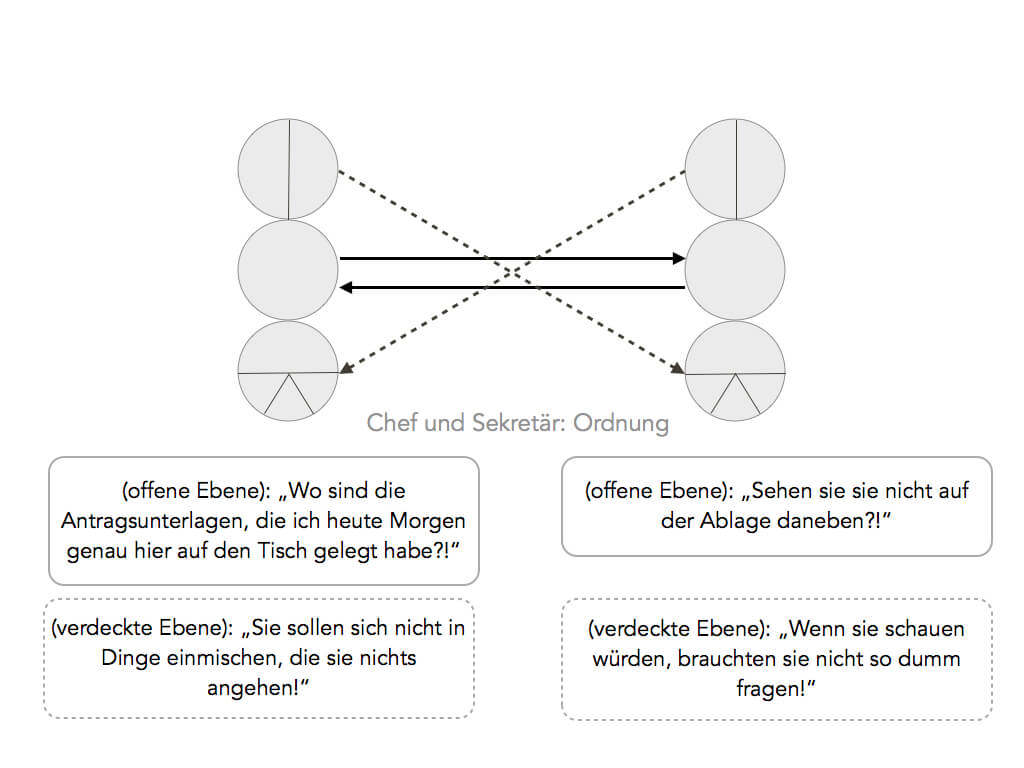
15 Psychological games
The teaching of psychological games is one of the Four pillars of classical transactional analysis. Eric Berne cleverly and humorously described dozens of communication patterns between people in „Adult games“ (1964)an early classic of TA literature and a bestseller in America in the 1960s.
Psychological games are communication patterns of covert transactions (Concept No. 14)which are ultimately concluded with great dissatisfaction or worse outcomes (violence, separation, death or prison). The ambiguity of the interactions between those involved is not recognised by them, so that they themselves are surprised and disappointed by the developments. Observers, however, recognise the pattern and are able to make certain „predictions“.
The concept is extremely important for mediators because they get into the situation at an early stage, detect hidden issues in the conflict and can influence unfavourable developments.
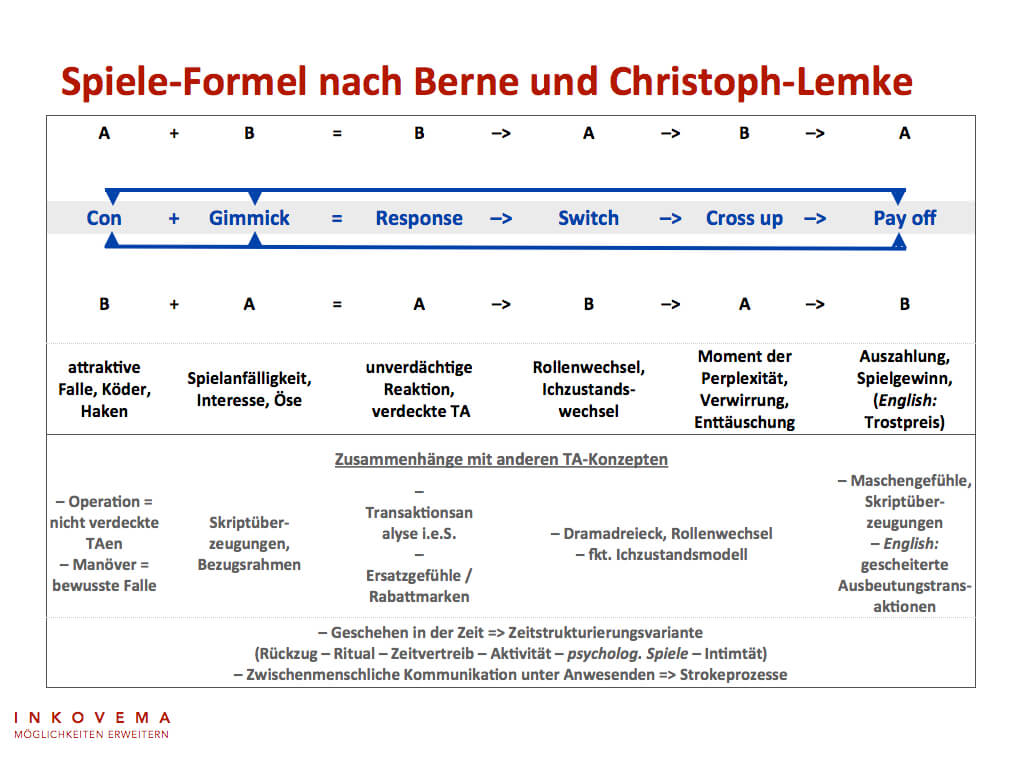
16. mediation matrix according to Kouwenhoven
In the handbook „…Transactional Analysis in Mediation“ (2014), the Dutch psychologist and mediator M. Kouwenhoven has presented a process model for mediation that makes it possible to analyse the Structuring the conflict resolution phase in mediation and to activate the autonomy of those involved.
17. basic feelings according to Thomson
The initial consideration is that Feelings a function-related appropriateness can be attested. In transactional analysis, the concept of basic feelings according to Thomson (ZTA 1989) available.
He names four basic feelings - Fear, anger, sadness, joy -which can be assigned to four basic behavioural modifications.
- Fear is the emotional reaction to Threatswhich are Caution and into a kind of compliant state leads.
- Trouble is the emotional reaction to Obstaclesthat lead to Tensions and one that resists, rebellious state.
- Mourning is the emotional reaction to Lossesthat lead to Helplessness and a withdrawn state leads.
- Joy is the emotional reaction to Freedom from problems and satisfactionthat lead to Looseness and carefreeness and leads to a free state.
In this concept, these four basic feelings have a historical reference point (time quality) and a life-sustaining function:
- Fear is on the Threatening future and is intended to hold harmless and offer security from the threat.
- Trouble is on the frustrating present and should have a changing effect and thus the Enable frustration management.
- Mourning is due to the (loss-)rich past and should have a solving effect and thus Enable farewell.
- Joy is on the (pleasure)rich presence and should Express joy for the Joy will. What else?
For mediators, this simple concept is ideal for categorising the corresponding emotional phenomena and checking whether they are appropriate or whether there is possibly a confusing ambiguity. This regularly proves to be a key to Deep structure of the conflict represent.
By the way, as a preventative measure: this is not a form of therapeutic mediation.
18. substitute feelings after English
A substitute feeling is a A feeling that tends to take the place of another feeling that is more appropriate to the situation experienced.
When we humans have to come to terms with a serious loss, for example, it is not appropriate to feel joy or anger. Feelings of sadness are perfectly appropriate in this case, even if they are still „forbidden“ for some with their biographical experiences („Don't be sad! It was only a hamster!“).
In Krylov's fable, the fox doesn't manage to plough the cherries that are hanging too high from the tree…actually annoying and then sad…but the fox just says succinctly: „They're sour anyway! “ – This is how you escape an unpleasant feeling - and cultivate a substitute feeling (of arrogance).
The substitute feeling takes the place of the actual „appropriate“ feelings, if these were once not allowed and unwanted. With a certain amount of practice and consistency, which we were all allowed to enjoy sufficiently in our childhood and school days, we may have learnt to be sweet and cute instead of sad or angry. Depending on what was received by the others, the powerful. Because substitute feelings are established in overpowering situations (social learning processes).
By no means only in the immediate family, but there intensively, in general there is/was a certain „emotional culture“ in the social environment that could „tempt us to substitute feelings“. Today, we sometimes find it difficult to recognise substitute feelings as such because they feel real. Only others sense that something is „not quite right“. However, the person themselves „is not acting“ but really feels and it takes some effort and reflection, but above all practice, to expand their own emotional range, to experience - to enjoy. Oh, how liberating it can be to allow grief, deep sadness, to be felt! And how enjoyable a proper fit of anger is! And just how intelligent our decisions can be can be experienced by those who listen carefully to their fear and literally find out what it has to say.
In conflicts, the mediator often comes into contact with substitute feelings. The concept can help them not to "fall prey" to them, but to be a „good mirror“ for the mediants.
To the Example I remember a mediator who always became sad and cried when she was verbally hurt by the other party again. By telling her „ that this was a rather annoying situation for me to experience, she was gradually able to develop access to her feelings of anger – and a little later found her previously genuinely felt sadness almost peculiar. Now, later on, when it was really time to say goodbye to previous ideas, sadness could be given space again, but this time appropriately.
19. relationship needs of Erskine
Conflicts between people are sometimes a „tragic expression of unfulfilled needs“ (M. Rosenberg). For this reason alone, it is necessary for mediators to have an idea of the different needs of people.
Since Berne, transactional analysis has recognised both physical and psychological basic needs (Concept No. 29)For conflict situations, it also helps to have a concrete idea of what needs exist within a relationship.
Richard Erskine has eight such relationship needs He has identified with couples due to his decades of counselling work.
- Need for security
- Need for appreciation from others
- Need for acceptance and recognition
- Need to be understood and to have personal experiences confirmed
- Need for confirmation of uniqueness
- Need to be able to exert perceptible influence on others
- Need for someone else to take the initiative
- The need to be able to express love, affection or affection.
All these needs exist not only or primarily in relation to the conflict partner, but also in relation to the mediator in different mixes. In my experience, this concept can be used to recognise helpful patterns and avoid difficult pitfalls when analysing the deep structure of the conflict. This by no means only applies to mediations in couple conflicts, but in particular to conflicts in the workplace and in the work team. This is all too understandable, as we spend a large part of our time with our work colleagues.
20. driver dynamics according to Kahler
TA recognises 5 driver dynamics, which are not only an established concept in the context of burnout prevention and management far beyond the TA scene, but are also extremely suitable, to recognise and decelerate conflict dynamics.
The Five driver dynamics are:
- „Be (always) perfect!“
- „Be (always) strong!“
- „Hurry‘ up (always)!“
- „Strictly‘ yourself (always)!“
- „Make ’it right for others (always)!“
The concept is of course also suitable for mediators to prepare themselves and to be well „centred“ themselves – perfectly prepared, so to speak ;-)
21. system dynamics according to Mohr
The system dynamics according to Günther Mohr are a Metaconcept for appropriate diagnosis and intervention in organisations. This is particularly important for mediation work in and with organisations or when using conflict management and mediation skills as part of systematic conflict management in organisations. Even a brief introduction to the concept would go beyond the scope of this blog post, which is why I will merely refer to Mohr's essay on the system dynamics in conflict management. Manual „TA in mediation“ (2014, p. 455 – 468) present this overview here.
22. the 3 Ps according to Crossman
Mediators need the ability to recognise themselves (and others) confidently through a problematic and sometimes nerve-wracking communication and conflict resolution process control.
The American transaction analyst Pat Crossman offers guidelines for counsellors and process facilitators, which can also be helpful for mediators to develop a Appropriate inner attitude to be able to accompany people in crisis or conflict situations in a mindful way.
The abbreviation "3P" stands for Permission, Protection, Potency. Mediators offer permission, protection and strength during the mediation process, which is expressed in an "enquiring attitude". The mediator's questions encourage the mediators to talk about issues that are sometimes even taboo. open which is only possible if this is done in a protected framework, which is also characterised by the emotional Strength of the third party.
The "3Ps" offer a quick orientation and basis for appropriate hypothesising when it comes to finding out what the conflict parties "need" in the specific situation in order to be able to deal with their conflict, including its "unsavoury depths".
23 Stroke filter
Strokes belong to the Psycho-physiological basic needswhich transactional analysis identifies. Neglecting them not only leads to psychological problems, but also to biological complications and even death. A stroke is defined as a Unit of attention whether it is a favourable or unfavourable, positive or negative attention. Every form of attention, whether recognition or rejection, affection or aversion, is a stroke.
In this context, positive strokes are, so to speak, acknowledgements that affirm behaviour or being, regardless of moral or other value-based judgements. Negative strokes are those that negate or reject behaviour or being. (Sometimes this is not sufficiently recognised in the literature, but even more so in the practice of transactional analysis. Strokes per se have a morally good and positive connotation. The theory of strokes gives no indication of this).
The stroke filter is a metaphor for the phenomenon that people literally block out and do not perceive certain attentions, while they perceive others all the more clearly. This is where the conceptual idea that we humans determine the filter settings ourselves can. We are able to take praise seriously and categorise criticism appropriately. We do not have to accept praise as a danger of idleness and criticism as an irrefutable eternal truth.
24. stroke hunger
Stroke hunger simply refers to the psycho-physiological fact that we need strokes in order to survive. Without attention, people die. Like air, food and water, it is essential for life. For this reason, we are sometimes forced to come up with strange things to escape death.
Some even paint volleyballs so as not to die…- and almost die for them.
…ergreifend.
The concept can sometimes offer explanations for the seemingly inexplicable things that people do or say in conflict situations.
25. role concept
The Role concept of systemic transactional analysis differs from the role concept of sociology, in which a social role - roughly simplified - is the Entirety the Behavioural expectation labelled.
One transaction-analytical role provides after Bernd Schmid a coherent system of Attitudes, feelings, behaviours, perceptions of reality and associated relationships represents. A highly complex term, but one that has been tried and tested in practical (counselling) work.
As a mediator, this model is primarily useful in the Context of organisation. It helps to explain structurally induced conflicts between role holders and to recognise the different role requirements as one of several recognise and reflect on the causes to the extent necessary and introduce them into the mediation discussion.
In connection with the role concept of transactional analysis, the world concept cannot go unmentioned.
26. world models
Systemic transactional analysis (especially through Schmid and Moor The theory formulated in this regard) identifies (now) five worlds whose cultures have an effect on people (better: role bearers) or are to be brought into balance by them. According to their dynamics and logic, there is a tendency for the individual worlds to try to completely take over people. We struggle to separate the professional and private worlds. We seem to be increasingly exposed to the temptation to bow to the pressure of the organisational world, even in our private lives (key point: constant availability). And we sell the whole thing to ourselves as a sign of professionalism. Or are the better arguments in favour of our world concepts 1.0 being overtaken by Industry 4.0? Whichever way you look at it, the fact is that fulfilling roles competently and in a resource-orientated manner is one of the primary tasks of modern people.
The five worlds are
- Professional world
- Organisational world
- Private world
- Community world
- Consumer world
27 Group dynamic concepts
The Bernese group concepts belong in a list of TA concepts for mediation. But to discuss them in detail would go beyond even the generous scope of this blog post. For mediators, however, Eric Berne's explanations are a treasure trove of references and material for reflection.
28 Functional Fluency Model
The FF model is an empirically tested model of human functioning and enables a – scientifically based – behavioural diagnosis, which is helpful for mediators to diagnose the conflict and cooperation processes within highly escalated conflicts and to plan and implement or evaluate appropriate interventions.
The model is a further development of the transaction-analytical ego state theory, which attempts to remedy the original "constructional deficiencies" and incorporate linguistic accuracy. The latter is important for the theoretical discourse, but is hardly used sufficiently in TA practice.
29. basic needs
Transactional analysis distinguishes between basic physiological and psycho-physiological needs. Basic physiological needs include food, clothing and space, i.e. protection or shelter. The psycho-physiological basic needs include Stimulation, structure and strokes (Concept No. 23)
Stimulation clarifies whether the senses - touch, taste, smell, sight and hearing - are sufficiently stimulated. Their stimulation is essential for our well-being. The need for structure asks about the quality of time. How do I spend my time? Are there patterns; are they helpful, beneficial or harmful?
30th Bonding cycle according to Kohlrieser
In order to adequately recognise bonding phenomena, it is worth looking at the Bonding cycle as described by G. Kohlrieser has described. As a former hostage negotiator, the concept is enriched with years of experience in acute, highly escalated conflict situations, which is worth using and studying for mediation.
31st Eight interventions after Berne
Berne had identified 8 interventions for his counselling work. The TA-savvy mediator can use this categorisation system as a guide to achieve clarity in the course of the process. Only a few adjustments to the mediative context and mandate are required in order to use the forms of intervention appropriately for the role.
The eight interventions are:
- Survey = Less for personal information, more for intervention, for highlighting key points.
- Emphasis = Important points are marked by paraphrasing.
- Confrontation = Highlighting information from the parties involved that indicates a contradiction and incompatibility. ("You say you can't stand each other, but you spend most of your time together, even though nobody forces you to?"; "What do you want to tell each other with your mutual silence?").
- Explanation = By offering a TA concept (e.g. the drama triangle), the mode of the adult ego is stimulated and activated by looking at and reflecting on a conflict situation with the TA concept.
- Visualisation = Is a comparison, a parable or an anecdote that follows on from the statements of the parties involved and introduces a certain confrontation. Humorous, mitigating if necessary. Does not quite correspond to the concept of metaphor work in mediation, as an illustration does not offer a solution direction, unlike a metaphor.
- Confirmation = An affirmation. Very popular with mediators, especially at the beginning.
- Interpretation = This is an experiential interpretation that is by no means appropriate in every mediation context, but should certainly be considered in the case of protracted conflict processes in long-term relationships (family, work).
- Crystallisation = Is a situation in which the mediating parties are faced with a decision after all conceivable aspects have been considered and taken into account. Mediation in itself is already decision-orientated, which is why TA as a decision-orientated counselling process (decisional TA) is a wonderful addition.
32. contract concept
The transaction-analytical contract concept helps the mediator to structure and (repeatedly) clarify the dialogue process, how all parties involved in the mediation want to get along so that they do not make a mistake. The contract concept is a process-orientated instrument that enables clarification. It utilises the All-round agreement as a counselling and processing method and in this way ensures the personal responsibility of the parties involved. This preliminary transaction-analytical work is a steep pass for the tasks and procedures of mediators.
33. cultural diagnosis of organisations according to Balling
Balling's concept of cultural diagnosis is ideal for mediation in organisational contexts. This is because it is not unlikely that the mediants will "bring their organisational solution culture with them" - and thereby exacerbate the common problem, the conflict. This is where the mediator (and the mediants) can help themselves if they risk taking a look at the organisational culture and do not see mediation as a closed space.
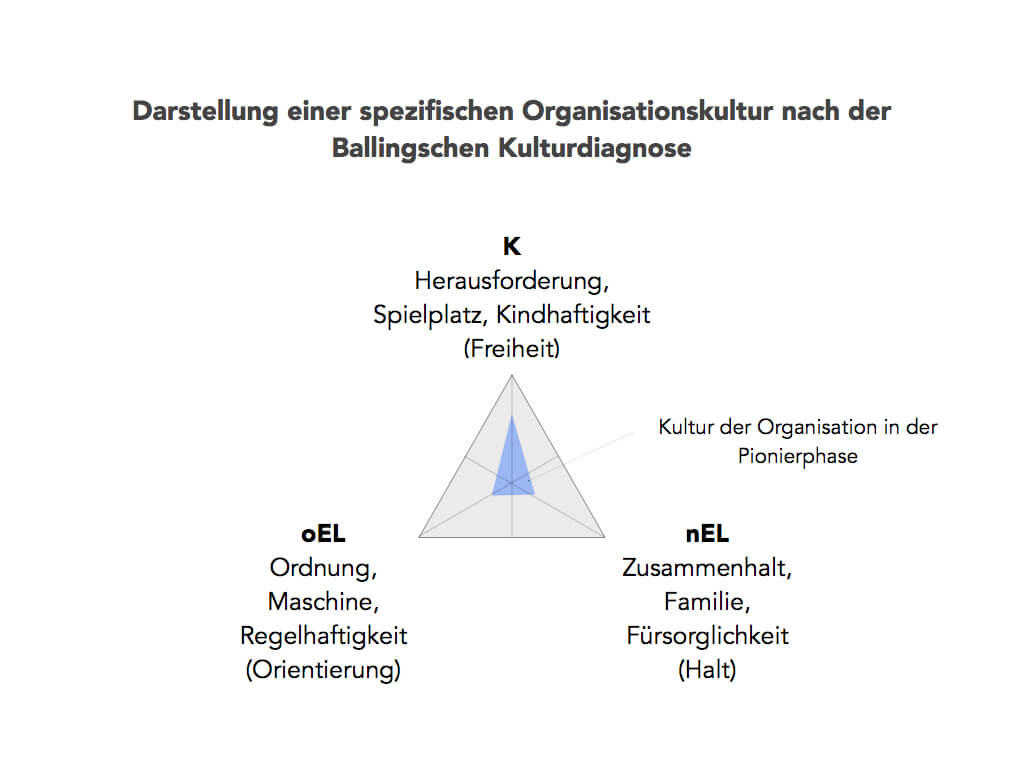
These are the 33 TA concepts for mediation that I have briefly presented here in a more or less arbitrary list. Of course, serious mediation work requires further, completely different concepts, but the ones presented here will take a conflict mediator quite far.
Which TA concept do you think is missing from the list? Which non-TA concept can you recommend instead of one of the concepts presented here? Write to me! I look forward to hearing from you!
bw.
Thanks to N. B. Andrade for the helpful feedback in advance!

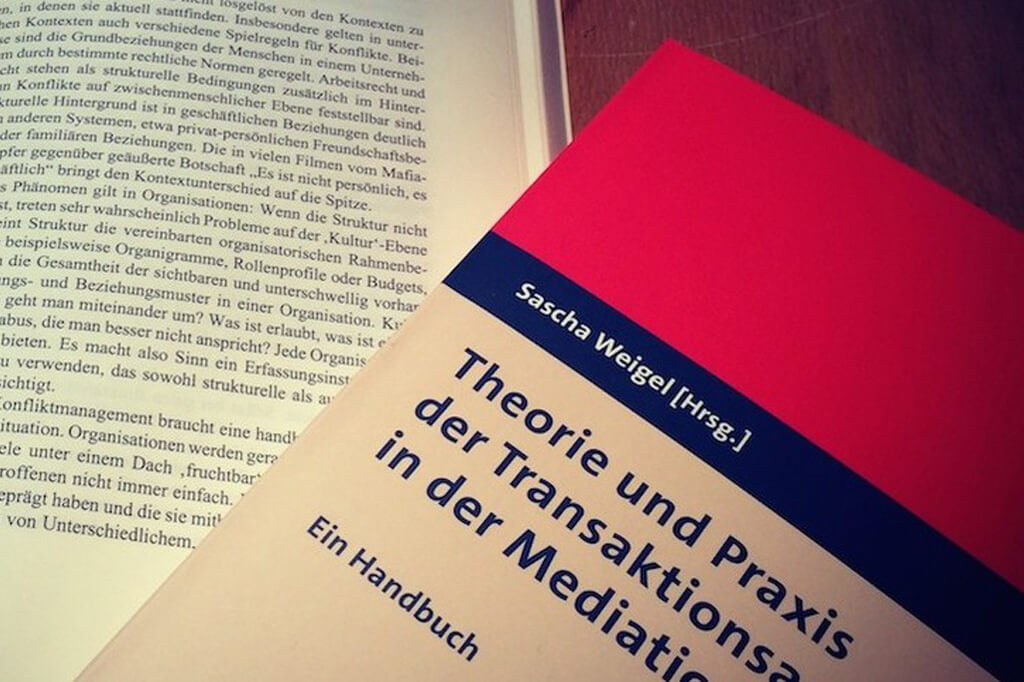
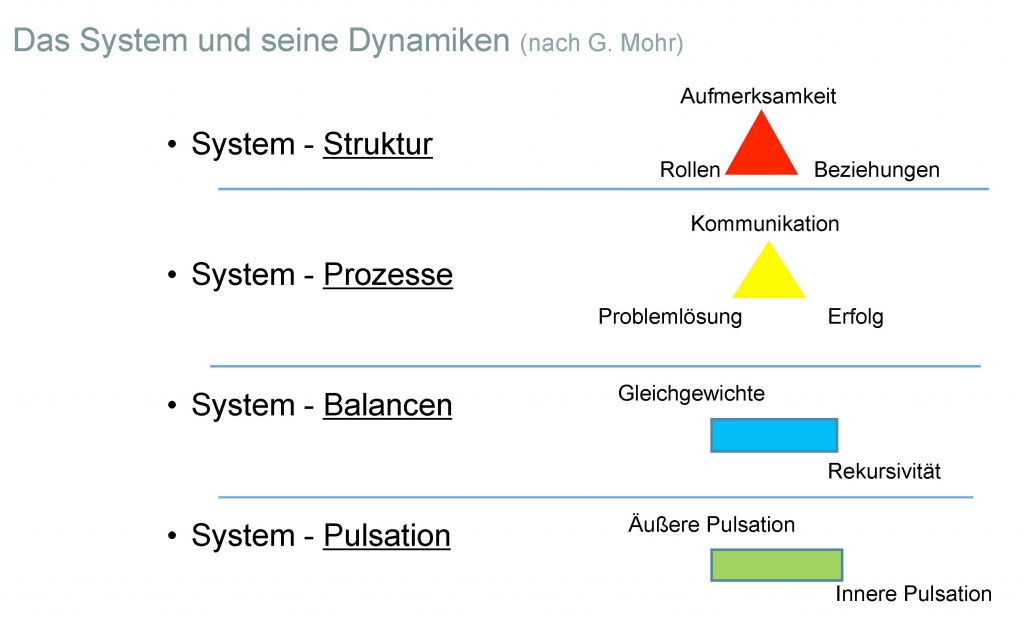
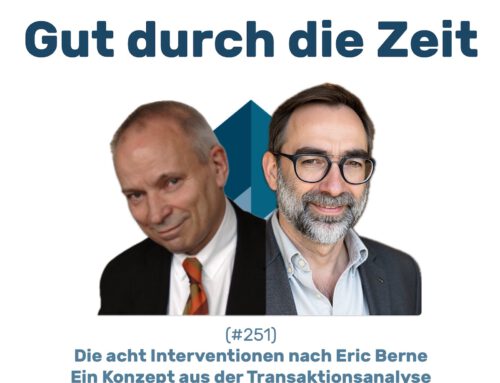
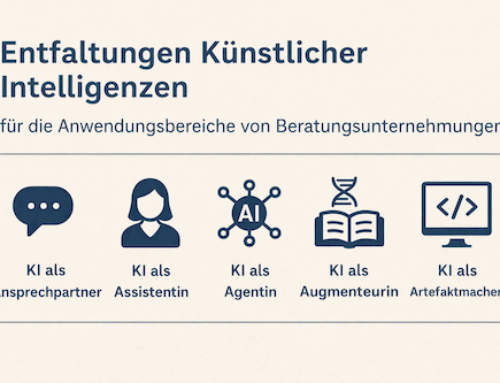

Thank you for this great article, which covers exactly what I was looking for: How do TA and mediation fit together, or what does TA offer conceptually to mediation?
As devaluations were recently a topic in my own TA training, I was very pleased about the literature tip on this.
It would also be interesting to consider the extent to which symbiosis (see Schiff School) is another concept that should be taken into account in mediation.
You're very welcome, Sven. Conceptually, the articles in the handbook "Theorie und Praxis der TA in der Mediation" (2014, ed. by Sascha Weigel ;-)) fit this topic in more detail and with further practical applications.
There is also an article by Chr. Küster on p. 331 that deals intensively with the symbiosis concept in the context of mediation.